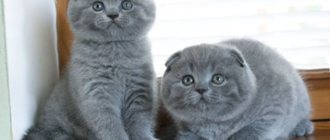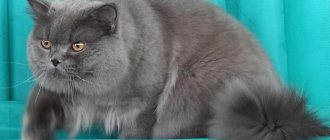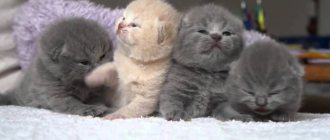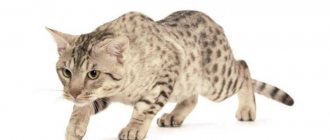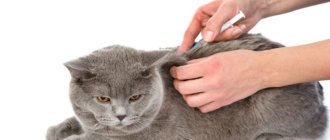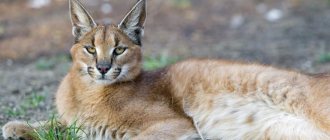Crossing Scottish cats to continue a high-quality breeding line should only take place under supervision and according to the rules approved by international felinological clubs.
In this regard, inexperienced owners have questions about what needs to be done to ensure that their pet has healthy offspring. Let's learn how to properly organize mating of Scottish Fold cats at home.
The right age for mating
Scottish Folds belong to a group of fairly robust medium-sized cats. Like other animals, they enter sexual maturity at 8-9 months. But by this time, the female’s young body has not yet become stronger and pregnancy during the first or second heat will greatly affect the development of the pet. Therefore, a Scottish cat can be bred for the first time at the age of 1.5 years.
A Scottish Fold cat may be younger than his chosen one, but for the first mating it is still worth choosing a partner with experience. It’s very bad when they both don’t have practical skills and don’t know which way to approach each other. In addition, the cat at the first mating usually begins to scratch, lie on her side and is not able to understand what she needs to do. In this case, you will need the help of an experienced instructor.
Important! If owners do not plan to use the Scottish Fold for breeding, it is recommended to spay or neuter him.
What pets can be crossed
At the end of the selection, clear recommendations for breeding were given. Violation of the instructions will certainly lead to a recurrence of hereditary diseases.
Genetically, animals must belong to different groups:
That leaves the final group Fdfd. In such a pair, one of the parents is lop-eared, and the other is straight-eared. Kittens are born mixed - half inherit the characteristics of the mother cat, and the second - the father.
Who can breed a Scottish Fold cat with?
The issue of choosing a mating partner in the Scottish Fold group plays a major role. It's all about complex genetics, which affects the health of the offspring, their immunity and compliance with breed qualities. Breeders have never been able to achieve sustainable results when breeding fold-eared cats.
Small flaws in the breed remain, but negative consequences can only be avoided if Scottish Fold cats are bred according to the rules, even at home.
Fold is caused by the presence of a simple dominant gene FdFd in the genetic map of the animal.
The very first Scottish Fold cat was bred with ordinary cats. As soon as the group expanded and boys with drooping ears appeared, they were also included in the breeding plan.
Due to inbreeding (closely related mating of mother and sons or brothers and sisters), animals developed problems with joints and bones. It was possible to breed Scottish Fold cats with ordinary cats, but in this case the breeders would get both straight-eared and fold-eared children. And the experimenters really wanted all the kittens to be real folds.
All hereditary diseases were then attributed to intrabreed mating, and almost put an end to the future fate of the Scottish Fold. Later, the Americans abandoned the idea of producing 100% of the offspring with the auricle mutation, and began to cross both lines (straight-eared and curved-eared), thereby rehabilitating the unique animals. They developed a strategy, approved standards and launched the mass breeding of Scottish fold cats at home and in nurseries.
British + Scots
Tell me, is it possible to match a “Scottish” with a “British”? Or should these breeds not be mixed? Tatiana.
In general, cats are not very scrupulous regarding morality, so the most common breed is RANDOM. As for their owners... You know, you can’t pick flowers from a flowerbed either, because they tear them, so and so!
British Shorthair
British Shorthair and Scottish Shorthair cats were closely related throughout the history of the formation of the Scottish Fold breed (“fold” is a fold, in this case on the ears) - Scottish Fold cats were bred with straight-eared British cats (since the gene for folding is related to to semi-lethal genes, mating between two fold-eared cats is prohibited (!), otherwise the offspring may have skeletal deformations incompatible with life, hereditary diseases, etc.)
In the British breed, mating of British with Scots is prohibited. But to maintain the pedigree data of the Scottish cat breed, matings of Scots and British cats were allowed. The kittens resulting from such a mating were always recorded in the metric as Scottish: fold-eared - like Scottish Fold, straight-eared - like Scottish Straight.
This was the case until 2004. Over time, the Scots began to differ from the British not only in the features of their ears, but also in other characteristics: the length of the body, tail and limbs. Scottish dogs have a more open muzzle with round and large eyes, reminiscent of a cute baby face. They are lighter in structure than British cats, not as large and stocky as British cats, their bodies are more elongated, their heads are round in shape, and have soft outlines. For the Scots, developed cheeks, like the British, are undesirable, which disrupt the round shape of the head. Scottish Straights also differ from the British in the size and position of their ears; their ears are smaller than those of the British and not as wide at the base. The thickness of the ear cartilage in Scottish Straight cats is less than that of British cats, and the cartilage itself is softer to the touch. The Scottish Straight has a slightly longer coat than the British.
Scottish Shorthair
The Scottish Straight differs from the Scottish Fold only in having straight ears. And therefore, in 2004, the Scottish Straight breed was registered with the WCF (World Cat Federation) as the “Scottish Shorthair” breed with the right to participate in the championship.
All standards of the Scottish breed must be preserved, so today they mainly breed Scottish Folds with Scottish Straights and very rarely breed with British dogs, especially since such interbreed matings have been prohibited in the WCF since 2004.
A British cat can only be crossed with a British cat. Kittens born as a result of mating a British cat with a representative of another breed are not considered British.
Mating of British and Scottish cats -2
The profile of the blog is cat health, so all issues are considered in this vein.
For an introduction, a little about genes (literally on the fingers):
At birth, every organism receives each gene twice—one from the father and one from the mother. If these genes are different, then the individual will be heterozygous for this gene, if they are the same, then homozygous . The main, stronger, suppressive gene is called dominant , and the weaker, suppressed gene is recessive .
For example, both parents have dark hair, which means that the child receives two identical genes (dark/dark) responsible for hair color, that is, he is homozygous for this gene and his hair should also be dark. If the father is brunette and the mother is blonde, then the child’s hair color gene is heterozygous. If the father's gene is dominant, then the child will turn out to be dark-haired (dark/light), but he will be a carrier of a recessive light gene (perhaps someday in other generations this light-hair gene will appear). May the geneticists forgive me, in reality everything is much more complicated, but for the concept of lop-eared genes this will be enough.
Who is the Scottish Fold?
This is a mutant.
Why can such a cute creature be called a word from a horror movie? Yes, because Fold is the owner of an “abnormal” mutated cartilage gene that is unable to support the weight of the ear in a standing position.
Ears are the main breed characteristic of the Scottish Fold cat. According to the standard, they should be small, with slightly rounded tips. Curved forward and directed towards the middle of the muzzle, the ears are pressed tightly to the head, which gives it a round shape.
What's hiding behind those cute little ears? Osteochondrodysplasia. Do you think the cartilage tissue mutant gene only affects the ears? No matter how it is!
Cartilage is an important structural tissue that provides support to parts of the body that do not have bones. Cartilage is also closely connected to bones, providing a smooth surface of the joints, ease and painlessness of movements.
Cartilage plays an important role in the growth and formation of bones in young animals. The fetal skeleton initially consists of cartilage, which is gradually replaced by bone. Growth in bone length is associated with the establishment of cartilage in special parts of the bone - disc-shaped growth plates. In a process called endochondral ossification, cartilage is replaced by bone tissue.
Thus, abnormalities in cartilage development can have major consequences for joint and bone formation.
In Scottish Folds, a cartilage abnormality due to a mutant gene can manifest itself in disorders of the musculoskeletal system, shortening of bones, fusion of the vertebrae and thickening of the joints, which causes lameness, chronic pain, and deformation of the limbs.
This is the gene for lop-earedness! That is, in the Scottish breed, initially at the genetic level there are anomalies in the skeleton and, consequently, in health in general.
The Scottish Fold breed originated in Scotland in the 1960s. And although it was initially recognized in the UK, in 1974 it was excluded from the list of recognized breeds due to harm to the health of cats due to deformation of the limbs and tail. The breed is also banned by the International Cat Federation and other organizations as inhumane. The breeding of the Scots was transferred to the USA, where geneticists found a solution that made the existence of the breed possible.
Who to breed a Scotsman with?
Mating of two folds (homozygous mating)
It would seem that the most natural way to fix the fold-eared gene in a breed (let’s denote it Fd ) is the mating of two folds. But it is then that negative manifestations of the mutation occur in the offspring.
The result of mating two folds is osteochondrodysplasia. The abnormality of the cartilage that causes the ears to “float” has a devastating effect on other parts of the body, especially the limbs. Homozygous cats have an abnormally thick tail that is rigid at the base. This is due to abnormally short, wide, and fused vertebrae. The legs are short with deformed limbs. The metatarsals, metacarpals (bones that connect the fingers and wrist), and hock joint (ankle/paw) are distorted and widened.
Over time, inflammation and pain begin in the joints of the lower extremities - osteoarthritis. Exostoses (growing bone formations extending beyond the surface of the bone) form around them. This occurs due to defects in endochondral ossification in these bones. The result of these processes is deformation of the limbs, a decrease in their ability to bear a load, gait disturbance, lameness, and chronic pain. The progression of these abnormalities leads to the fact that affected cats cannot walk.
The pathology can become apparent in cats as early as seven weeks of age and persist throughout life.
Thus, the lop ear gene in homozygous form ( FdFd ) is dangerous! Therefore, for all felinological systems there is a ban on mating fold + fold
Mating of fold and straight (heterozygous mating)
It is clear that in order to “dilute” the fatal gene, a fold-eared cat must be bred with a straight-eared cat (straight-eared gene fd).
As a result of such matings, kittens with the Fd fd gene sets appear - these are folds with a fold on the ears (since the Fd is dominant) and fdfd are straight-eared straight cats. Now the terrible combination of FdFd is no longer present. It would seem that the problem with osteochondrodysplasia has been solved. Unfortunately, it is not.
And heterozygous Scots may also have primary development of limb deformities, although, of course, less severe than in homozygous individuals. And pathology (arthritis, bone exostoses) develops more slowly and at a later age. The disease can manifest itself from very mild to severe.
The diagnosis is confirmed by x-ray, computed tomography or MRI (magnetic resonance imaging).
The disease is genetic, cure as such. Animals are prescribed chondroprotectors, painkillers and anti-inflammatory drugs for joints. In some cases, surgery on the affected joints has been successfully used to remove bony exostoses to reduce lameness and pain. Currently, radiation therapy has also begun to be used. Particularly affected animals are subject to euthanasia.
Kittens
From a breeding point of view, the Scots breed is interesting for its unpredictability. It's just some kind of lottery. You can never know exactly how many folds ( Fd fd) and how many straights (fdfd) there will be in a litter (theoretically 50 to 50, practically...).
All Scottish kittens are born with straight, erect ears. Around the 21st day, some kittens' ears begin to fold - these are future folds. Those kittens whose ears remain unchanged are straight. But here lies another catch.
Over time, the ears of folds may partially stand up, which is very sad from the point of view of breeding. It happens that it is difficult for the untrained eye to distinguish a real straight from a “straightened” fold. And then there is a risk of crossing fold with fold out of ignorance, which is not good. Eh, when will a genetic marker appear to clearly identify the Fd from a blood or saliva sample?!
From questions to the first article:
— Tell me, the kitten’s ears are starting to rise a little, can they stand up at all? And then I can turn him into a straight guy, even though his ears were hanging when he was a child?
— Tell me, please, if I have a Scottish Fold cat with erect ears, is it possible to breed with a Scottish Fold cat also with erect ears, or will there still be deformities?
- Hello! I have a British cat and a straight-eared Scottish cat, can their mating result in fold-eared kittens?
Answer:
If a kitten receives the Fd fd (loose-eared) set of genes from birth, then it remains that way for the rest of its life, regardless of whether the ears straighten or not. He always! will be considered a fold. A fold can only be knitted with a straight.
Straight-eared cats have a set of fdfd genes, and the fold-eared gene Fd will not appear from their mating. That is, two straights (whether Scottish or British, it doesn’t matter) will not fold!
Mating of British and Scottish cats -3
Why Scots can't be mated with Britons
Why not? After all, this is what they did before - a fold-eared Scot was mated with a straight-eared Briton, and everything was in order with the gene set. The British were used as material to obtain the recognized Scottish Fold breed (there was no Scottish Straight breed as such). Until 2004.
In 2004, the World Cat Federation (WCF) officially registered a new Scottish Straight breed with the right to participate in the Championship. Hooray!! Thus, in Russia, the Scottish straight-eared cat has become an independent breed with its own mandatory standards. And these standards differ from the standards of other breeds, from the British in particular.
At the same time, in 2004, a resolution was adopted to ban cross-breed matings, since from now on the Scots and the British are two completely different breeds, having different standards and a different point scale at the Championship. Like this!
Single matings can now be carried out only for the breeding work of the club, accompanied by a reasonable entry in the club’s stud book, the issuance of an experimental pedigree and further control over the offspring.
In the United States, the Scottish Fold is still bred to British or American Shorthair cats. Well, they don’t have the Scottish Straight breed, but we in Russia do!
So, since 2004, the mating of a Scotsman and a Briton is an interbreed mating that blurs the breed characteristics and thereby worsens both breeds. The result is an average standard, neither this nor that. The main feature of the Scottish Fold – the ears – also suffers. More on this below.
But it's not just a matter of distortion of the breed. Health also suffers.
The British skeleton consists of short, powerful bones. Scottish cats have much lighter bones, a more flexible and longer tail, and more elongated caudal vertebrae. And this reduces the risk of skeletal disorders due to an abnormal cartilage gene.
Well, the British don’t need mating with the Scots in any way at all, since it doesn’t give anything, but only spoils their breed characteristics. British kittens are born only from a British couple!
Why should Scots be bred with Scots?
Thus, mixing the Scots with the British is bad. But with the Scots it’s good. Why?
For Scottish Folds, the main asset of the breed, which brings a significant part of the points at exhibitions and championships, is their ears. Initially, representatives of the breed simply had ears that “hung”, bending forward. Now, thanks to selection work, they have two or even three folds. The breed standard requires that fold ears be small, folded and not protrude beyond the contours of the head. Therefore, the task of breeders is to achieve maximum fit of the ears to the head.
And this factor is significantly influenced by modifier genes .
Scottish Straights, having straight ears, still carry hidden genetic information about the lop ears of one of their parents, which is passed on to the next generation.
Therefore, by crossing a lop-eared cat with a cat that has modifier genes for the same lop-earedness, you can achieve the best results in the offspring and get excellent show-class animals.
The British do not possess these modifier genes. And when interbreeding a Scottish Fold with a British dog, the result is kittens whose lop ears are based on the genetic material of only one parent - the Fold. The tightness of their ears often leaves much to be desired. Such kittens may have one sweet ear on their ears, and they are directed to the sides, and over time they can stand up. And such ears can turn out to be much wider and more powerful than the standard prescribes. Alas, not an exhibition option.
The Scottish Fold differs from the Scottish Straight only in its ears; all other breed characteristics are the same. Therefore, crossing them with each other improves the breed.
And, of course, mating two Scots, who have a lighter frame compared to the British, significantly reduces the risk of negative consequences of the mutated cartilage gene in offspring.
And finally about the patient.
So, Russia, having recognized the Scottish Straight breed, found itself “ahead of the rest.” It would seem that all owners of Scots should rejoice and throw all their efforts into improving the young breed. But no! Everything in our country is again... not as it should be.
Some of the “breeders” (put in quotation marks) still continue unjustified interbreed matings with the British under the slogan “they bred before, and nothing…”, thereby grossly blurring the breed characteristics.
Moreover, in order to get a litter consisting 100% of the popular Folds, completely unscrupulous owners cross Scottish Folds with each other, not caring at all about the health of the kittens.
What could this lead to? To the appearance of a layer of sick animals of an unknown breed. And they will ban the Scots here, like in Europe, and that’s it!
From the comments to the first article:
— We bought a kitten, Scottish fold, female, at the age of 1.5 months. After a couple of months, the ears straightened, not quite of course, they seemed to be directed forward, and the muzzle, it seems to me, became somehow sharper, although with cheeks. Now I have doubts about what breed my favorite belongs to, and what kind of offspring I should expect (my friends were promised kittens from our cat).
— The kitten’s mother cat is a cross between a Fold and a Straight, and the father is a breeding Fold — that’s what the breeder wrote to me... I look at the photo, the mother’s ears are neither this nor that... they don’t stick out like the British, for example, but they don’t hang like my kitten...
Answer:
Dear cat lovers, especially those who are just planning to get a kitten! If you want a healthy and purebred baby, contact clubs or real responsible breeders - where work with genetic material is carried out competently! Documents are required. It may be more expensive, but this is a guarantee that you will get a strong pet that meets all breed standards.
Don’t be fooled by advertisements like “I’ll sell a British lop-eared dog for 3 thousand rubles.” Unfortunately, our illiteracy contributes to the prosperity of such would-be breeders.
Of course, this applies to all breeds. But this is doubly true for the Scots breed, since it has genetic “pitfalls” that, if handled incorrectly, can lead to big problems.
The Scottish cat breed is interesting and unique. So let it be!
From the comments:
- Hello, I have a question. I have a Scottish Fold cat, if I cross her with a British cat, will the kittens be British or Scottish?
No comments.
caticat.ru
Why you can’t cross a fold-eared cat with a fold-eared cat
It is precisely in the plane of mating of two fold-eared parents that all the negative genetic consequences in kittens appear. It was proven first experimentally, and later scientific evidence appeared, that all congenital health problems in Scottish cats occur precisely because of this configuration.
Initially, it was believed that the FdFd gene, which is responsible for lop ears, exists in an autosomal dominant form. Later, the nature of his partial dominance was revealed, which changed the entire original concept.
- When mating two fold-eared FdFd, the heirs exhibit all the genetic defects - deformation of the tail and limbs, fusion of the vertebrae and other diseases.
- Crossing a fold-eared FdFd with the same fold-eared dog, but with Fdfd or fdFd, eliminates any health problems and produces offspring with curled ears.
- It is possible to mate Fdfd Fold (fdFd) and Scottish Straight fdfd. In this case, “mixed” children are born.
It turns out that you can breed a straight-eared cat (straight) with a fold-eared cat, and vice versa, there will be no negative impact on the health of the kittens in such a union. But when two Scottish folds are mated, you need to be sure that at least one of the parents has the homozygous Fdfd allele (fdFd).
There is one more. Some kittens have ears that fold first and later rise, although in fact the animals have genes for lop ears. A gradation has been developed according to which the Scots can have 1, 2 or even 3 folds. In the latter case, the auricle is 100% guaranteed to be adjacent to the head and there can no longer be any external changes to it. But the first option is the riskiest. Visually, the animal looks straight-eared, although it has the lop-eared gene.
If crossed with a Scottish Fold, the offspring will most likely get hereditary diseases. So when breeding straight-eared Scottish Straights, you need to have complete confidence in the consistency of the genetics and appearance of the pets.
Signs of pregnancy in Scottish cats
It is important to correctly determine that a cat is giving birth and how long pregnancy lasts in Scottish cats after mating. It is important to keep a calendar in which the first and all subsequent signs of pregnancy are noted.
How to understand and notice with the naked eye that a Scottish cat is pregnant? It is detected only in the sixth week. Indirect signs of pregnancy include:
- the cat goes through a period of toxicosis and feels sick in the morning;
- nipples enlarge, swell, become pink;
- There is an increased appetite and at the same time an aversion to some familiar types of food;
- her character changes, she withdraws, shuns her household;
- sleeps more than usual, is apathetic to games and affection.
The exact duration of pregnancy can be determined by a specialist only after 2 weeks using ultrasound or palpation. The duration of a Scottish cat's pregnancy lasts on average up to 65 days; if the cat is nursing and the kittens do not appear after 67 days, then a danger is created for the mother and her kittens. In this case, immediately seek help from a specialist. In critical moments, a caesarean section may be necessary.
By following calendar dates, they create comfortable conditions for the different stages of the cat’s birth and prepare in time for the actual birth of kittens. The course of the birth process is roughly divided into 3 periods.
https://youtube.com/watch?v=1-dSY-Ih3o4%3F
Proper organization of mating
The rules for mating Scottish cats consist of the following points:
Pet owners also need to decide on whose territory the Scottish breeding will take place in order to prepare the premises. Traditionally, the cat plays the role of “master,” but this issue can be discussed.
If the “groom” is already untied and has experience, then he almost doesn’t care in what territory the mating will take place. The same rule applies to cats - at first they do not yet know what to do, but later they cope with the task perfectly in any room.
Important! The mating process lasts for several days. At this time, the owner of the apartment must control the behavior of the cats and ensure that they do not harm each other.
How does the mating process work?
Estrus in a Scottish cat lasts from 5 days to 1.5 weeks. At this time, her behavior changes, she shows signs of sexual desire, worries, rubs against the owner’s legs, shows excessive affection or, conversely, becomes aggressive.
Cats meow very annoyingly, their behavior becomes more nervous, they also mark their territory with an odorous secretion.
Mating of Scottish Fold and Straight-eared cats is prescribed on the 2-3rd day of estrus. The process goes like this:
The mating moment itself lasts 10-25 seconds, and then the animals disperse. The cat and cat rest, and then the cycle repeats again. There can be 8-10 such iterations per hour, and the entire crossing process continues for several days.
Important! Under normal conditions, a 2-3 day mating of healthy Scottish Fold cats provides an almost 100% guarantee of pregnancy and high-quality offspring.
Mating
Curled ears are the result of a genetic mutation and the calling card of Scottish Fold cats, or “Scots.” A cartilage defect is the direct cause of lop ears in representatives of this breed. Therefore, if they are not bred very skillfully, serious pathologies with the musculoskeletal system or tail can occur.
If the purpose of mating is to improve the breed, then select individuals whose appearance is as close as possible to the breed standard. Features of Scottish Fold cats are as follows:
- the head is round, with round whisker pads and a short, wide nose;
- the ears are small, curved down and forward, and fit compactly to the head;
- from the rounded tip of the ear to its lobe, a right angle with its apex on the lobe appears;
- the eyes are large and round, widely spaced;
- the coat is short, thick, soft, spreading along the skin; can be of any color;
- the tail is tapering, with a round thickening at the tip, flexible;
- longer and tapering tails are considered more beautiful;
- The paws are muscular, of medium thickness and length.
There are 3 classes based on the severity of the characteristic features of the breed:
- Shows are animals with the most pronounced characteristics of the breed. The cats of this class are the most valuable, they are the ones chosen for mating;
- Breed – animals with slight deviations from the breed standard. Females are of greatest value for breeding. The offspring of a “breed” cat and a “show” cat can improve the breed;
- Pets are animals with significant deviations from the breed standard. They are not used by specialists for breeding, but are kept as pets.
At what age should you knit?
A cat's first heat begins at the age of 5–6 months, depending on the environment, climate and nutrition. It may not be too noticeable. If you breed a cat at this age, it can have a bad effect on her young body and cause further infertility, and the offspring may not be viable.
It is best to skip the first 2 heats. The most favorable age for breeding a cat is from 1 to 1.5 years, when it reaches full physical development. If the female is not untied until the age of 1.5 years, then later, during the first mating, she will show significant resistance to the cat.
Before introducing animals, it is advisable to trim the cat’s claws in order to protect the cat in case of aggression towards him. You should also make sure that the female is in satisfactory health, in particular, check her for common infections:
- mycoplasmosis;
- chlamydia;
- coronaviruses.
Who can this breed be crossed with?
In this breed there are cats and cats of two varieties: fold-eared - with curled ears and straight-eared - with erect ears.
Only fold-eared and straight-eared people can be confidently matched. In this case, the offspring will be genetically healthy. About half the kittens will be of the fold-eared variety, and half will be of the straight-eared variety.
It is risky to mix Scots with outbred cats, as well as with cats of any other breeds. The offspring can be either healthy or have health problems of varying severity.
You cannot reduce:
- Lop-eared with lop-eared. In this case, the defect in the cartilage tissue will affect not only the ears, and it will most likely be weak and sick. This will especially affect the limbs. Skeletal deformations, shortening of bones, thickening of joints, fusion of vertebrae are possible;
- Scots with British or exotics. The Scots have weak cartilage tissue, while the British have a heavy skeleton. When mating with Britons or exotics, kittens were born whose vertebrae fused in the future. The problems may turn out to be so serious that the only option left is to euthanize the animals.
